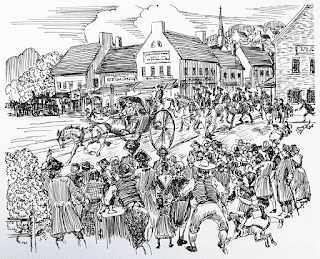It was an ordinary day. Looking back over the many stories I have written about my hometown of Lancaster, Pennsylvania to see if I may have written about Lancaster being our Nation's Capital for a day. I found a few references to that fact, but I hadn't gone into detail about it, so I thought I would write about my hometown one more time so you can see why Lancastrians are proud to have been the Capital of our nation for a day. It all began on September 11 when Sir William Howe's British forces engaged in battle with George Washington's Continental Army near Chadds Ford during Howe's move to capture Philadelphia. At the time it was the longest single-day battle of the war. The Redcoats defeated the American rebels and forced them to withdraw northeast toward Philadelphia. It was on September 19, 1777 that fourteen members of the Continental congress began fleeing Philadelphia to escape Lord Howe and his Redcoat Army. Congress decided it best if they move west toward Lancaster which was the next largest town in that direction. They traveled a round-about route, trying to throw off the enemy as they headed through Trenton, Easton, Bethlehem and Reading before finally arriving in Lancaster on September 27. They had in their possession the Declaraton of Independence for safekeeping. They also had a wagon with them that carried the Liberty Bell, but that broke down along the route and had to be abandoned. It was well-hidden in an Allentown church. Lancaster came alive that day in September when the delegates and other refugees crowded into the town with personalities such as John Hancock, Samuel Adams, Richard Henry Lee and Charles Carroll whom assembled with the Congress in the Courthouse to conduct the nation's business.
 |
| This is the only contemporary image of the first courthouse in the background. It was drawn in 1757 by Nicolaus Garrison, Jr. |
 |
| Lancaster residents greet the arrival of the Continental Congress. Drawing by C. Carlson. |
From there they could see as far west as the Susque- hanna River and several miles to the east, from where they had just arrived. The chief business on that historic Saturday was the safety of the government. After routine business and talking about means to supply General Washington with the necessary arms and supplies, they decided to move to safer ground.
 |
| Clockwise from top left: John Hancock, Samuel Adams, Richard Henry Lee and Charles Carroll. |

No comments:
Post a Comment